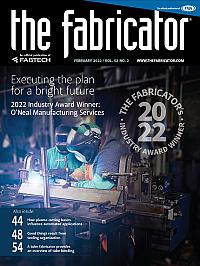Principal
- FMA
- The Fabricator
- FABTECH
- Canadian Metalworking
Categories
- Additive Manufacturing
- Aluminum Welding
- Arc Welding
- Assembly and Joining
- Automation and Robotics
- Bending and Forming
- Consumables
- Cutting and Weld Prep
- Electric Vehicles
- En Español
- Finishing
- Hydroforming
- Laser Cutting
- Laser Welding
- Machining
- Manufacturing Software
- Materials Handling
- Metals/Materials
- Oxyfuel Cutting
- Plasma Cutting
- Power Tools
- Punching and Other Holemaking
- Roll Forming
- Safety
- Sawing
- Shearing
- Shop Management
- Testing and Measuring
- Tube and Pipe Fabrication
- Tube and Pipe Production
- Waterjet Cutting
Industry Directory
Webcasts
Podcasts
FAB 40
Advertise
Subscribe
Account Login
Search
Reflecting on the progress of a lean manufacturing journey
Address three important areas to ensure a successful, long-term improvement strategy
- By Jeff Sipes
- February 23, 2022
- Article
- Shop Management
When you look in a mirror, you see your reflection in all its glory. Sometimes you are satisfied with that reflection, sometimes not. If you think of that reflection objectively, it becomes a data point, a statement of fact, and a basis upon which to assess improvement opportunities. You can, and should, apply the idea of reflection to your lean journey.
Place your organization, its processes, and your collective work behaviors in front of the mirror for an honest assessment. The primary reasons to do this are to understand and avoid backsliding and to make sure you have not settled into a sense of complacency.
Addressing three important areas helps ensure a successful, long-term improvement strategy. Although not an exhaustive list, they do provide a good starting point for your reflection.
1. Culture and Behavior
Your organization’s culture and behavior provide insight into how and why it operates as it does. Are you intentionally trying to impact the culture and how people behave? Although these terms might seem squishy, they are powerful indicators of long-term improvement success.
Culture focuses on shared values, goals, attributes, and practices demonstrated and used by people in the company. Your company culture emerges either organically without leadership’s attention or through intentional grooming and hard work. By happenstance or design, your company has a culture, and you should be intentionally impacting that culture throughout your lean journey.
How does your current culture compare to the culture your company had at the beginning of its lean journey? Do you have a shared focus on improvement throughout the organization? Does everyone believe the customer is the prime focus, or are you just punching the time clock? Finally, are leadership’s decisions and direction consistent with the desired culture?
One way to understand behavior within the company is to assess what people do when no one is looking. Sure, you could dictate behavior, but doing so probably wouldn’t be sustainable. Say a supervisor has to hover over a certain part of the plant to make sure production employees do a job in a certain way, perform preventive maintenance tasks, or return from break at a certain time. If the production supervisor has to “enforce” these actions, they’re not likely to stick.
If employees demonstrated an understanding of punctuality, standard work, and how they impact upstream and downstream processes, then the actions described previously would not need the production supervisor’s constant oversight and meddling. Employees should just do them, even when no one is looking.
Are desired behaviors clearly communicated and understood? Do we lead in a way that enables the desired behaviors to occur? Do we solicit from and provide feedback to the organization about behavioral performance? You could ask all these questions and others as you reflect on your company’s improvement.
2. Principles and Concepts
These provide a framework for improvement. Put another way, they help you understand why you are doing what you are doing. If no one understands why you are continually training employees, moving or adjusting process flows, and measuring leading and lagging indicators, then you may be stoking confusion and skepticism.
Fundamental to the lean body of knowledge are the “respect for people” and “operate with humility” principles. They apply to everyone, from the CEO to the new hire on the shop floor.
Next, consider some basic lean manufacturing concepts like “make one, move one”; “customer-visit-ready, any day, any time, no advance notice necessary”; and “never pass along a defect.” This short list only scratches the surface, but note how these concepts put desirable outcomes into layman’s terms—no jargon, no complicated phrases, just commonsense blocking-and-tackling descriptions.
When reflecting, you might ask, How effectively are our operating principles documented, communicated, and understood? How well does our workforce understand the connection between the critical improvement concepts and supporting actions? And have we effectively enabled and engaged our workforce?
3. Tools and Methods
The principles and concepts set the stage for tactical elements—the tools and methods you use on your lean journey. They are much more tangible compared to the first two areas, which makes them easier to see and understand. But beware. All three of these topics must be considered. They are like three gears that must be meshed together for the transmission of power to happen.
Tools and methods represent the different types of analysis, various ways to achieve improved performance, and specific techniques to drive out waste and variation. Take a look at the agenda for lean and green belt-level Six Sigma training, and you will see the tools and methods you would expect to see in your improvement toolbox.
How to conduct a muda walk, shorten changeover times, streamline process flow, and conduct scatter-plot analysis—these just whet the appetite for tools and methods in the lean body of knowledge. Maybe you even get into design of experiments to take a deeper dive and identify critical process characteristics to ensure that your improvement efforts are most effective in a particularly troublesome process.
Reflection questions here might include, Do we have an effective process for training and refreshing the workforce? How do we measure knowledge retention? Have we set an expectation that tools and methods must be used for problem-solving? And is there a measure to help us understand period-over-period improvement?
Assessing and Reflecting
The reflective questions described here are far from exhaustive. The exact questions most relevant for you and your company will depend on the maturity in your lean journey, business issues unique to your company and industry, and other factors.
The value of going through this reflection exercise is to determine the questions that you and your leadership team identify as important. You may find that some members of the leadership team are not on the same page; what one person thinks is critical another person sees as irrelevant.
Take the time to be very intentional about creating the reflection template for both you and your company. And not everyone’s template will be the same. Someone else with a different area of responsibility will have a different reflection template. The reflection template for the company should consider topics for which leaders have reached consensus. Lack of consensus is an important and meaningful finding that probably requires attention.
Should such reflection be a formal process or an informal one? That depends on your situation. It could be formal when you create a specific survey instrument, collect and collate data, apply statistical thinking and analysis, and deliver a formal report. This could provide important input into your company’s strategic planning process. Such reflection could also occur informally in a facilitated way that’s cascaded downward and upward throughout the organization.
Any reflection will be effective as long as it has some structure and a defined way to use the results of the reflection. You will either confirm that you’re on the right path or change direction. Either way should move your lean journey forward, as long as your reflection is honest and objective.
Reflection provides an opportunity for you, individuals within the company, and the organization as a whole to stop the merry-go-round of daily duties and challenges. It gives you a safe and quiet environment to evaluate the recent past and contemplate the near future. When you do this exercise, recognize that the reflection and assessment may spotlight backsliding, complacency, or other less-than-desirable outcomes. That is not a bad thing. On the contrary, reflection provides an objective basis for improvement. So, hold up that mirror, see what you learn, and make the business better this year than it was last year.
About the Author

Jeff Sipes
9250 Eagle Meadow Dr.
Indianapolis, IN 46234
(317) 439-7960
subscribe now

The Fabricator is North America's leading magazine for the metal forming and fabricating industry. The magazine delivers the news, technical articles, and case histories that enable fabricators to do their jobs more efficiently. The Fabricator has served the industry since 1970.
start your free subscription- Stay connected from anywhere

Easily access valuable industry resources now with full access to the digital edition of The Fabricator.

Easily access valuable industry resources now with full access to the digital edition of The Welder.

Easily access valuable industry resources now with full access to the digital edition of The Tube and Pipe Journal.
- Podcasting
- Podcast:
- The Fabricator Podcast
- Published:
- 04/16/2024
- Running Time:
- 63:29
In this episode of The Fabricator Podcast, Caleb Chamberlain, co-founder and CEO of OSH Cut, discusses his company’s...
- Trending Articles
How to set a press brake backgauge manually

Capturing, recording equipment inspection data for FMEA

Tips for creating sheet metal tubes with perforations

Are two heads better than one in fiber laser cutting?

Hypertherm Associates implements Rapyuta Robotics AMRs in warehouse

- Industry Events
16th Annual Safety Conference
- April 30 - May 1, 2024
- Elgin,
Pipe and Tube Conference
- May 21 - 22, 2024
- Omaha, NE
World-Class Roll Forming Workshop
- June 5 - 6, 2024
- Louisville, KY
Advanced Laser Application Workshop
- June 25 - 27, 2024
- Novi, MI



























